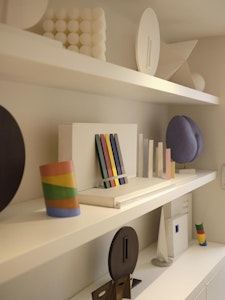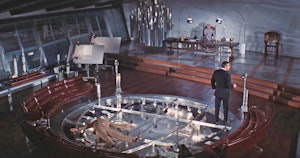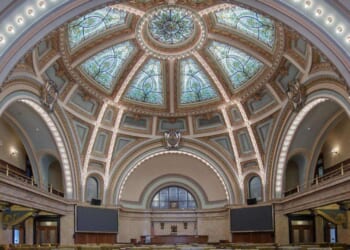This article is taken from the April 2025 issue of The Critic. To get the full magazine why not subscribe? Right now we’re offering five issues for just £10.
This is a story about time travel. In Battersea. I went to visit one of the last survivors of the “sixties”, a cultural commodity, possibly now an antique commodity, not a mere ten calendar years.
He is George Ciancimino, aged 97. I have known him very slightly for a long time. Elegant, affable, tanned, confident, relaxed, garrulous, but also quietly insistent in a charming way. And difficult to define. I think he makes it so.
On my way, walking through the park, I thought in a stream- of-consciousness way about the decade he survived. Time magazine’s “Swinging London” article was published in April 1966 and sanctified the era and its ways, although Diana Vreeland had declared London to be swinging in US Vogue the year before. Perhaps Vreeland had visited Dolly’s Disco on Jermyn Street.
Ciancimino is a priest of a forgotten cult keeping old rites alive
Probably not Bernie Ecclestone’s MG dealership in Bromley which had white tiles, plate glass and spotlights: Bernie was an unlikely pioneer of architectural minimalism. Customers included Twiggy and Lulu. More likely Vreeland visited Biba, the store on Kensington High Street.
Although the West End had its shout, really it was Chelsea. The King’s Road: Pheasantry, Granny Takes a Trip, Casserole, Le Reve, Hung on You, Guys & Dolls, Bazaar, Top Gear, Countdown. Best of all, The Chelsea Drugstore, inspired by Le Drugstore on Boulevard Saint-Germain. It had its own “flying squad” of delivery girls in purple catsuits who drove scooters.

The hairdressing Schumi brothers. Zev Aram’s modernist furniture in his King’s Road shop. Sergeant Pepper. I almost forgot Habitat. But everyone has now forgotten Habitat. If you are under 50, the name “Terence Conran”, a sixties person if ever there was one, has little resonance. No one even makes chicken brick jokes any more.
And then the reverie ended. I was now in Battersea, which an ambitious estate agent might call south Chelsea, ringing Ciancimino chimes. Nearby lived Enzo Apicella, a gloriously- moustachioed leader of the Italian diaspora. What had begun with Sidoli’s coffee bar in Rhyl in 1910, moved onto Bar Italia in 1949 and culminated in Apicella’s 1965 Pizza Express in Soho and soon in Fulham. This diaspora was like the Grand Tour of the milordi, but in reverse. Apicella died in 2018, aged 96. Something about South London evidently vitalises elderly Italian playmakers.

George Ciancimino opens the door and offers me a glass of wine. It is 10:57 in the morning. I mention this Italian diaspora. “I was born in Algiers,” Ciancimino quickly says and winces, when I mention, excusing my error, that he shares a family name with a notorious Sicilian crime family. “I am French,” he adds, warmly shuffling me into the interior. “I was raised by the Jesuits. I am still a Roman Catholic.”
The house is calm and beautiful. The immaculate white carpets enjoy the ample light on even this dull day. Modern furniture complements renaissance and oriental artefacts and some antiquarian books. It does not look much lived-in, but I think it has been designed to be looked at. The displays are fastidiously arranged. Everything just-so. This sense of order, Ciancimino says, was acquired from time spent in the Marine Nationale, based in Porquerolles.

In the long, wide river of Ciancimino’s life there have been many currents and cross-currents. He tells the stories well, but is not overly pedantic about dates. It must have been like this listening to Homer and other oral historians. Let me get this narrative out of the way before discussing what’s most interesting: an absolute dedication to his sixties craft.
He wanted to be an aircraft designer, but there was insufficient opportunity or demand in the Maghreb, so he was put onto telecoms. One result of this was the ability, he says, to speak Morse Code as fast as he can speak English — which is very fast indeed. (His mother’s first husband had been an Eighth Army surgeon). During this period, he scavenged components from aircraft cemeteries in the Sahara.
He had been directed towards art by a banker whose name he cannot recall, but the direction was the making of him. Accordingly, there was time spent in Paris as an assistant to a sculptor. He had been on his way to Vallauris to join Picasso, but was diverted. This was, I infer, in the fifties. Soon after, he was in New York working for Jens Risom, a Danish-American Mid-Century Modern furniture designer. In 1941 Risom had made a chair using US Army webbing which became an early best-seller for Knoll. Like the scavenged aircraft parts, this sort of improv was influential on Ciancimino’s method.

At about this time, his brother Jean-Claude opened an antique shop in Pimlico, where George eventually found himself making things. There was lots of chrome and glass. Sixties trophies followed, women and cars, including an inevitable period-correct Jaguar E-Type which he called a hot-dog because it was brown.
The stillness of the house and its generous display of his prints, collages and maquettes is almost like stepping into a Morandi still-life, but more brightly lit. However, others are included in this exhibition: there are sketches and scribbles by his good friend, the graphic designer Alan Fletcher, who Ciancimino said was always “dressed in black, like a Sicilian widow”.
There are drawings of the Gherkin by the architect Ken Shuttleworth, whose claim on parentage of this City landmark riled his one-time employer, Norman Foster. Additionally, there are cocos de mer on tall white plinths. This is the giant sea coconut of the Indian Ocean, once prized by collectors of exotic fruit, not least because of its unambiguous erotic form. Ciancimino has covered one in gold and the other is purple. Breasts or buttocks? Hard to say. It was the same in the skinny sixties.
But most of all, the walls and shelves are covered with Ciancimino’s own work. A shredding-machine is one of his chief studio tools. That and a glue gun. “I am a sculptor who does paintings and collages” he says. Layer upon layer of finely chopped paper is painted and glued and arranged in laminations which create intensely saturated colours in their geometrical arrangements. Rather like a Bauhaus colour chart modelled on a dish of potato rostis. “My shapes are so simple, they have to be made perfectly”. His cutting-board is spotless.
Elsewhere there are maquettes and little devices which create optical illusions involving lines and space (an explanatory digression on astrophysics lost me). Ciancimino’s work defies strict definition, but collage, sculpture, design and visual tricks are all involved. Like an ever-expanding Universe, activity is continuous and ceaseless.
And there are designs for furniture everywhere. The style is a deluxe modernismo. Ciancimino furniture appears in 1971’s Diamonds are Forever. It is entirely congruent with set designer’s Ken Adams’s lavish Art- Deco/space-station aesthetic. Ciancimino’s 1965 Cloverleaf System coffee table (with smoked glass top) would sit comfortably in Blofeld’s lair.

At a recent sale at Farrando in Paris one such table fell just short of its estimate — and to correct what he may see as recent neglect by the marketplace, Ciancimino has self-published a book of unrealised furniture projects.
But since the seventies there have continued to be brushes with commercial recognition for his designs, including the appearance in the 1995-6 New York Museum of Modern Art Wholesale Catalog of a solid wood coat rack which allows the hooks to fold flat when not in use. Fletcher said “I’ve been to the MoMA shop. It’s full of your stuff.” An amiable exaggeration, perhaps, but an indication of the camaraderie Ciancimino so values.
It’s an exquisite irony that the “sixties” sensibility — when being modern was compulsory — has become quaintly archaic. Like modern jazz, which was once so daring, modern design has become mainstream, polite and suddenly very dated. An era is at its end when its illusions disappear. But for Ciancimino, those illusions are still happily real — a priest of a forgotten cult keeping old rites alive.
I knew another sixties survivor who, after great success, spent the rest of his life tinkering in solitary. This was Alex Moulton, famous for his collaboration with Alec Issigonis on the ur-Mini’s ingenious suspension, then more famous still for the small-wheeled bike that bears his name. Moulton lived alone in a fine house outside Bath, fettling his steam-engined launch and trying, but never quite managing, to recover a well-earned, but fading, celebrity.
But I enjoy what Ciancimino does and admire his commitment to doing it. A house as a studio and exhibition is a nice idea and a fine way of life. He is the equivalent in art and design of the man of letters in literature. And what is, or was, a man of letters? An adept, immersed in his subject, with opinions commanding respect, with aphorisms to spare. I mentioned Nietzsche’s opinion that all of life is a question of taste. “Oh, I thought I said that,” Ciancimino rejoined cheerfully.
Simple questions are always the best. Why? “I don’t do it for money. I do it for myself.” That is both sad and true, but it is noble as well.







